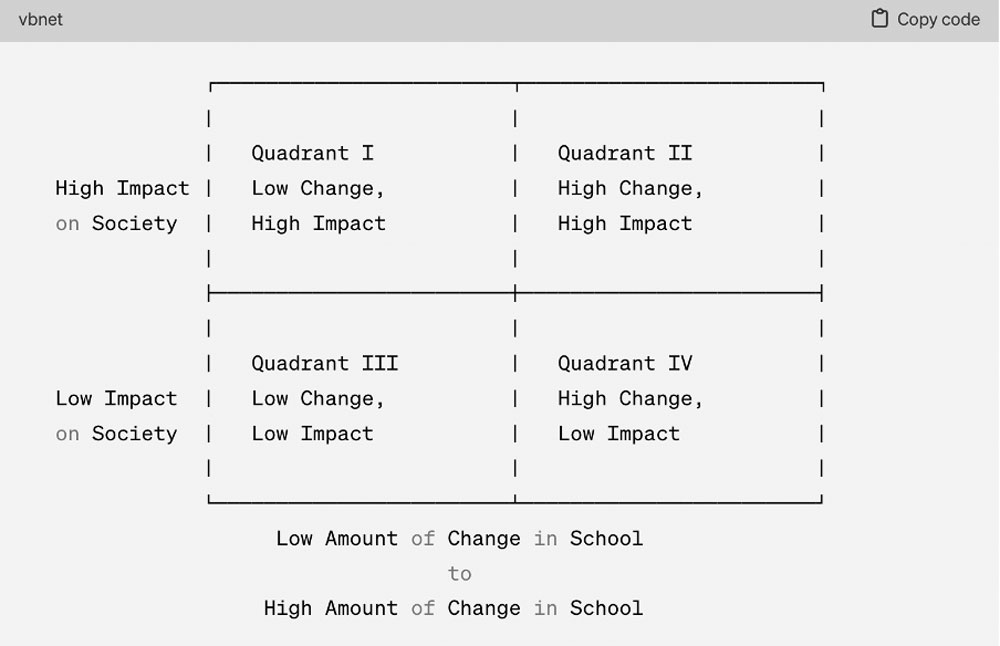
Prompt: “Create a photorealistic image of transparent, ruby red dice being rolled at extreme close up, and in the dice are the GPUs, chip hardware, data and electricity to symbolize AI.” (Photo source: Dale Plotzki, DallE3)
--------------------------------------------------------------
The 2023-2024 school year has felt like a chance for us to catch our breath, if only for a moment. After the tumultuous start to the second semester in 2022-2023, when ChatGPT seemed poised to rug-pull everything we know about school, this school year has felt like a time to pump the brakes, look around, and begin planning for the road ahead.
Many schools are already off and running in this endeavor. They have had the community discussions. They have launched the dedicated professional development days. They have drafted the first iteration of artificial intelligence (AI) policies and procedures. They have formed the focus groups to test and evaluate tools. Yet at the same time, most schools are holding onto the belief that we can somehow make AI fit into school, rather than thinking of how we can make school fit into a new AI centered world. No one knows how large of an impact artificial intelligence will have on our society, but I think we can all agree that there is at least the potential of a sea change in the months and years to come. And if that is the case, it might be worth considering what the outcomes for schools might be depending on how much we are able to adapt.
Let’s use a helpful concept from game theory called a Nash Equilibrium to explore this idea. This is a way to figure out the best possible outcome in a non-cooperative game. Or put another way, it’s how to figure out what you should do when the outcome is unclear. We can map our ideas on a simple 2x2 grid. On the y-axis we can plot the amount of change AI will have on society. And on the x-axis, we will plot the extent to which schools enact change in response to AI. It would look something like this:

(Photo source: Dale Plotzki, GPT4)
Let's start in Quadrant 1 and work our way around clockwise. In Quadrant 1, AI changes society greatly, but schools adopt little change in response. This is the worst-case scenario for all. Students no longer feel prepared for the world they live in. Students feel more and more disillusioned with the work they are doing in school and anxious about their place in the world. A massive skills gap develops in society. School becomes a harder and harder place to be for all.
Quadrant 2 on the other hand might be the best-case scenario. This is where schools pivot their teaching and learning to grow with the changes brought by AI. New pathways open up in school where students feel engaged, prepared, and fulfilled in their work. Students harness the tools and mindsets needed to participate in a largely AI driven world. Rote learning tasks are handled by AI in a fraction of the time they took when they were human led. Teachers spend their time helping facilitate students on their own personal projects, running businesses, performing community service, exercising, creating, and connecting. Machines do what they are good at, and humans do what we are good at.
Quadrant 3 we might call the status quo. All of this tech ultimately does not change much about the world around us, and neither does school. It is business as usual for all involved: standardised tests, essays, bells, and age groupings. It is getting harder and harder to believe that this is the path we are headed towards though. AI is already leaving a massive thumbprint on the way we work and think about learning. Believing that it somehow all stops here seems an obviously flawed idea.
Quadrant 4 we might call the “overreach” scenario. Here, schools implement disruptive changes in anticipation of a world that never materializes. Money and training are misallocated, and resources are squandered. Although this is not an ideal outcome, this scenario could still bring about positive advancements in school that are necessary even if they are not directly contributing to AI-preparedness. Things like more choice, autonomy, and authentic, real-world learning. Schools make a dramatic shift and adopt changes that are arguably long overdue.
In Quadrant 2 we see the development of a Nash Equilibrium; the best possible outcome for both learners and society given the other choices. It is clear that “business as usual” cannot be our plan moving forward. In the best-case scenario, that means sticking with the status-quo with all of its pros and cons. In the worst-case scenario, it means deeply failing to prepare our kids for their futures on almost every level.
AI is going to force the hand of schools to make some long put-off decisions. If schools want to keep their doors open in the future, we need to ask ourselves what we are going to do to move to Quadrant 2? What policies, skills, and mindsets need to be harnessed in the age of AI? What industrial-era structures can we finally let go of? How can we move both teachers and students towards a new agreement of what learning is and what it is we do inside of a school? The road ahead will be difficult, but stepping up to this challenge is really the only choice we have.
--------------------------------------------------------------
Dale Plotzki is the Technology and Learning Innovation Coordinator at the International School of Busan in Busan, South Korea.
X: @dale_rickardo